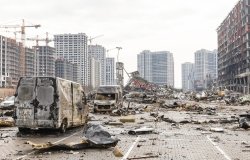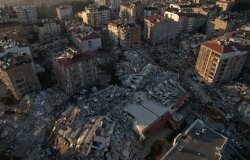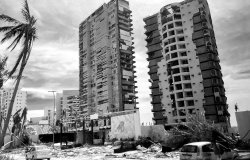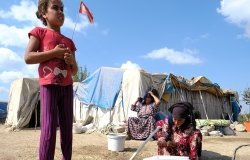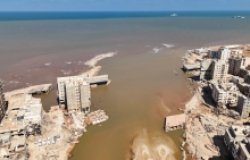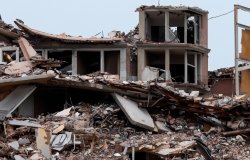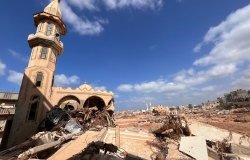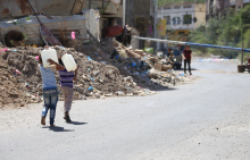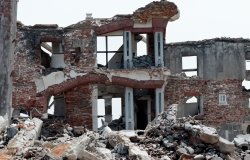Green Recovery and Reconstruction Training Toolkit for Humanitarian Aid: Rebuilding Stronger, Safer, Environmentally Sustainable Communities after Disasters
The "Green Recovery and Reconstruction Training Toolkit", created by the World Wildlife Fund and the American Red Cross, will help future humanitarian efforts integrate principles of environmental conservation into their disaster recovery strategies.
Overview
Natural disasters present an immediate humanitarian crisis but are also an opportunity to rebuild societies to be more resilient and environmentally sustainable than they were before. The "Green Recovery and Reconstruction Training Toolkit" (GRRT), created by World Wildlife Fund (WWF) and the American Red Cross and launched at the Wilson Center on November 19, will help future humanitarian efforts integrate principles of environmental conservation into their disaster recovery strategies. This strategic partnership has been "an incredible effort and marriage between organizations that have different operating styles, different approaches to situations," said WWF Chief Operating Officer Marcia Marsh. While implementing the GRRT may not be easy, "we need integrated solutions for integrated problems," said Erika Clesceri, bureau environmental officer at USAID.
A Critical Partnership
In the midst of a crisis, humanitarian workers on the ground often do not have the time, skills, or funding to incorporate environmental concerns into relief efforts, said Robert Laprade, senior director for emergencies and humanitarian assistance at CARE. Humanitarian workers are "going a hundred miles an hour, they're going on adrenaline and they're there to save people's lives--and the environment is just of secondary importance," he said.
But "environmental sustainability is critical to the achievement of long-lasting recovery results," said Roger Lowe, senior vice president of communications at American Red Cross. The Red Cross Principles of Conduct state that "relief aid must strive to reduce future vulnerabilities to disaster as well as meeting basic needs" and "avoid long-term beneficiary dependence upon external aid," he said.
From Damnation, Purgatory, and Armageddon to Redemption
For many crisis-stricken regions, lack of an emphasis on environmental sustainability during disaster recovery efforts can mean "damnation in the present, purgatory in the near future, and Armageddon in the long term," said Peter Walker, director of the Feinstein International Center at Tufts University. Stress on the environment caused by climate change or unsustainable resource consumption can often contribute to conflict, he explained.
In Darfur, "the environmental change was part and parcel of what led to that conflict," Walker said. At one time an "environmental Eden" of diverse ecological zones, Darfur gradually became an environment that could not support a society of livestock herding. As the environment changed, some former herders became salaried, armed gunmen, known as the Janjaweed who felt they faced "a choice of no choice," Walker said, to either "die as pastoralists or become pariahs as mercenaries."
The challenge for humanitarian aid organizations is to not only help communities recover from disasters, but help them adapt to future environmental stress caused by globalization, climate change, or other factors. "If you cannot adapt," Walker said, "that's going to lead to violence." To avoid aid dependency or resurgence in conflict it is critical to integrate environmental sustainability into disaster relief efforts from the beginning, he said:
We used to believe that our world in the aid business was divided between relief on the left and long-term development on the right, and one would gradually go into the other in this relief-development continuum. But the reality is that you have a significant population – a population of millions of people - who are effectively trapped in a form of aid purgatory. They're basically on a drip feed. Humanitarian assistance does not get you forward, it keeps you alive.
The GRRT offers organizations guidelines for implementing integrated disaster relief to provide a sustainable solution. While every crisis is different, the GRRT's guidelines should be as applicable to "flooding in Boston as they are to flooding in Aceh," said Walker.
Implementing Integrated Solutions
Securing funding for this integrated approach will be a challenge, as a significant portion will go towards staffing and training people on the ground, said Clesceri. A stand-alone, dedicated budget for environmental issues within humanitarian assistance programs must "be fought and re-fought for on a continual basis," she said.
Local partnerships are essential. "Replicate" should be "stricken from the lexicon," said Marsh. "You can't replicate, and this toolkit isn't meant to be a one-size-fits-all." Instead, she said, the goal of the GRRT is to "create very practical approaches with communities."
The key to helping communities recover from disasters is to form the kinds of strategic partnerships demonstrated by WWF and the American Red Cross in the creation of the GRRT. "Interdisciplinary groups are always, in my mind, going to get you a better solution in the end, but the risk is that they take more time…but it's absolutely worth it," she said.
Drafted by Hannah Marqusee and edited by Schuyler Null and Meaghan Parker.
Documents & Downloads
- Green Recovery and Reconstruction Training Toolkit for Humanitarian Aid: Rebuilding Stronger, Safer, Environmentally Sustainable Communities after DisastersDownload
- Green Recovery and Reconstruction Training Toolkit for Humanitarian Aid: Rebuilding Stronger, Safer, Environmentally Sustainable Communities after DisastersDownload
Speakers
Hosted By

Environmental Change and Security Program
The Environmental Change and Security Program (ECSP) explores the connections between environmental change, health, and population dynamics and their links to conflict, human insecurity, and foreign policy. Read more
Thank you for your interest in this event. Please send any feedback or questions to our Events staff.

